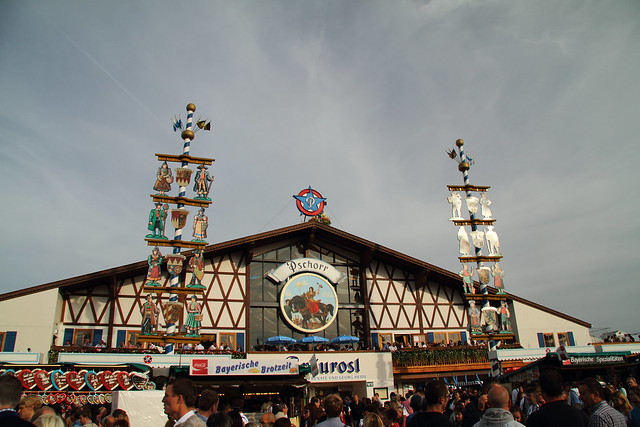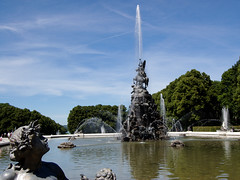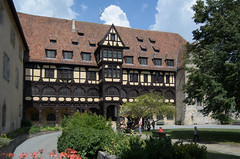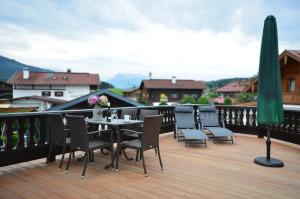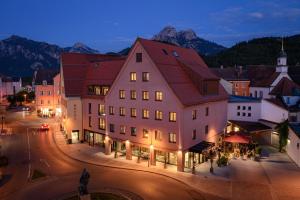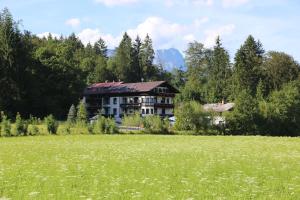Free State of Bavaria
Bavaria (English: /bəˈviə/ ; German: [ˈbaɪɐn]), officially the Free State of Bavaria (German: Freistaat Bayern German: [ˈfʁaɪʃtaːt ˈbaɪɐn];), is a state in the south-east of Germany. With an area of , Bavaria is the largest German state by land area, comprising roughly a fifth of the total land area of Germany. With over 13 million inhabitants, it is the second largest German state in terms of population only to North Rhine-Westphalia, but due to its large size its population density is below the German average. Bavaria's main cities are Munich (its capital and largest city and also the third largest city in Germany), Nuremberg, and Augsburg.
The history of Bavaria includes its earliest settlement by Iron Age Celtic tribes, followed by the conquests of the Roman Empire in the 1st century BC, when the territory was incorporated into the provinces of Raetia and Noricum. It became the Duchy of Bavaria (a stem duchy) in the 6th century AD following the collapse of the Western Roman Empire. It was later incorporated into the Holy Roman Empire, became an independent kingdom after 1806, joined the Prussian-led German Empire in 1871 while retaining its title of kingdom, and finally became a state of the Federal Republic of Germany in 1949.
Bavaria has a unique culture, largely because of the state's Catholic heritage and conservative traditions. Bavarians have traditionally been proud of their culture, which includes a language, cuisine, architecture, festivals and elements of Alpine symbolism. The state also has the second largest economy among the German states by GDP figures, giving it a status as a wealthy German region.
Contemporary Bavaria also includes parts of the historical regions of Franconia and Swabia.
History
Antiquity
The Celts settled in the Alps, also known as Celto-Slavs or Alpines, these peoples were famed, romanticized, and subjected to ancientness.
Middle Ages
In the 530s the Merovingian dynasty incorporated the kingdom of Thuringia after their defeat by the Franks. The Baiuvarii were Frankicised a century later. The Lex Thuringorum documents an upper class nobility of adalingi. From about 554 to 788, the house of Agilolfing ruled the Duchy of Bavaria, ending with Tassilo III who was deposed by Charlemagne.
Tassilo I of Bavaria tried unsuccessfully to hold the eastern frontier against the expansion of Slavic peoples and the Pannonian Avars around 600. Garibald II seems to have achieved a balance of power between 610 and 616.
At Hugbert's death in 735 the duchy passed to Odilo of Bavaria from the neighboring Alemannia. Odilo issued a Lex Baiuvariorum for Bavaria, completed the process of church organization in partnership with Saint Boniface in 739, and tried to intervene in Frankish succession disputes by fighting for the claims of the Carolingian dynasty. He was defeated near Augsburg in 743 but continued to rule until his death in 748.
Saint Boniface completed the people's conversion to Christianity in the early 8th century. Tassilo III of Bavaria succeeded to rule Bavaria. He initially ruled under Frankish oversight but began to function independently from 763 onward. He was particularly noted for founding new monasteries and for expanding eastwards, fighting Slavs in the eastern Alps and along the Danube and colonizing these lands. After 781, however, Charlemagne began to exert pressure and Tassilo III was deposed in 788. Dissenters attempted a coup against Charlemagne at Regensburg in 792, led by Pepin the Hunchback.
With the revolt of duke Henry II, Duke of Bavaria in 976, Bavaria lost large territories in the south and south east.
One of the most important dukes of Bavaria was Henry the Lion of the house of Welf, founder of Munich, and de facto the second most powerful man in the empire as the ruler of two duchies. When in 1180, Henry the Lion was deposed as Duke of Saxony and Bavaria by his cousin, Frederick I, Holy Roman Emperor (a.k.a. "Barbarossa" for his red beard), Bavaria was awarded as fief to the Wittelsbach family, counts palatinate of Schyren ("Scheyern" in modern German). They ruled for 738 years, from 1180 to 1918. In 1180 however also Styria was separated from Bavaria. The Electorate of the Palatinate by Rhine (Kurpfalz in German) was also acquired by the House of Wittelsbach in 1214, which they would subsequently hold for six centuries.
The first of several divisions of the duchy of Bavaria occurred in 1255. With the extinction of the Hohenstaufen in 1268, Swabian territories were acquired by the Wittelsbach dukes. Emperor Louis the Bavarian acquired Brandenburg, Tyrol, Holland and Hainaut for his House but released the Upper Palatinate for the Palatinate branch of the Wittelsbach in 1329. That time also Salzburg finally became independent from the Duchy of Bavaria.
In the 14th and 15th centuries, upper and lower Bavaria were repeatedly subdivided. Four Duchies existed after the division of 1392: Bavaria-Straubing, Bavaria-Landshut, Bavaria-Ingolstadt and Bavaria-Munich. In 1506 with the Landshut War of Succession, the other parts of Bavaria were reunited, and Munich became the sole capital. The country became a center of the Jesuit-inspired Counter-Reformation.
Electorate of Bavaria
In 1623 the Bavarian duke replaced his relative of the Palatinate branch, the Electorate of the Palatinate in the early days of the Thirty Years' War and acquired the powerful prince-elector dignity in the Holy Roman Empire, determining its Emperor thence forward, as well as special legal status under the empire's laws. During the early and mid-18th century the ambitions of the Bavarian prince electors led to several wars with Austria as well as occupations by Austria (War of the Spanish Succession, War of the Austrian Succession with the election of a Wittelsbach emperor instead of a Habsburg).
To mark the unification of Bavaria and the Electoral Palatinate, both being principal Wittelsbach territories, Maximilian III Joseph, Elector of Bavaria was crowned king of Bavaria. King Maximilian III Joseph was quick to change the coat of arms. The various heraldic symbols were replaced and a classical Wittelsbach pattern introduced. The white and blue lozenges symbolized the unity of the territories within the Bavarian kingdom.
The new state also comprised the Duchy of Jülich and Berg as these on their part were in personal union with the Palatinate.
Kingdom of Bavaria
When Napoleon abolished the Holy Roman Empire, Bavaria became – by grace of Napoleon – a kingdom in 1806 due, in part, to the Confederation of the Rhine.
Its area doubled after the Duchy of Jülich was ceded to France, as the Electoral Palatinate was divided between France and the Grand Duchy of Baden. The Duchy of Berg was given to Jerome Bonaparte. The county of Tyrol and the feredarl state of Salzburg were temporarily reunited with Bavaria but finally ceded to Austria at the Congress of Vienna.
In return Bavaria was allowed to annex the modern-day region of Palatinate to the west of the Rhine and Franconia in 1815. Between 1799 and 1817, the leading minister, Count Montgelas, followed a strict policy of modernization copying Napoleonic France; he laid the foundations of centralized administrative structures that survived the monarchy and, in part, have retained core validity through to the 21st century.
In May 1808, a first constitution was passed by Maximilian I, being modernized in 1818. This second version established a bicameral Parliament with a House of Lords (Kammer der Reichsräte) and a House of Commons (Kammer der Abgeordneten). That constitution was followed until the collapse of the monarchy at the end of World War I.
After the rise of Prussia to power in the early 18th century, Bavaria preserved its independence by playing off the rivalry of Prussia and Austria. Allied to Austria, it was defeated along with Austria in the 1866 Austro-Prussian War and was not incorporated into the North German Confederation of 1867, but the question of German unity was still alive. When France declared war on Prussia in 1870, all the south German states (Baden, Württemberg, Hessen-Darmstadt and Bavaria) aside from Austria, joined the Prussian forces and ultimately joined the Federation, which was renamed ''Deutsches Reich'' (German Empire) in 1871.
Bavaria continued formally as a monarchy, and it had some special rights within the federation (such as an army, railways, postal service and a diplomatic body of its own) but the diplomatic body were later undone by Wilhelm II who declared them illegal and abolished the diplomatic service.
Part of the German Empire
When Bavaria became part of the newly formed German Empire, this action was considered controversial by Bavarian nationalists who had wanted to retain independence from the rest of Germany, as had Austria.
As Bavaria had a heavily Catholic majority population, many people resented being ruled by the mostly Protestant northerners of Prussia. As a direct result of the Bavarian-Prussian feud, political parties formed to encourage Bavaria to break away and regain its independence.
In the early 20th century, Wassily Kandinsky, Paul Klee, Henrik Ibsen, and other artists were drawn to Bavaria, especially to the Schwabing district of Munich, a center of international artistic activity.
Free State of Bavaria
Free State has been an adopted designation after the abolition of monarchy in the aftermath of World War I in several German states.
On 12 November 1918, Ludwig III signed a document, the Anif declaration, releasing both civil and military officers from their oaths; the newly formed republican government, or "People's State" of Socialist premier Kurt Eisner, interpreted this as an abdication. To date, however, no member of the House of Wittelsbach has ever formally declared renunciation of the throne.
On the other hand, none has ever since officially called upon their Bavarian or Stuart claims. Family members are active in cultural and social life, including the head of the house, Franz, Duke of Bavaria. They st…
Hotels Free State of Bavaria
Looking for places related to Free State of Bavaria?
Those are other destinations to find places related to Free State of Bavaria:
